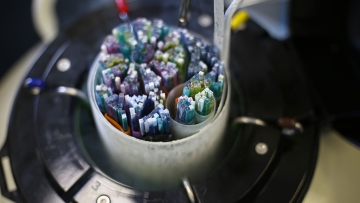Table of content:
Introduction
Why choose the frozen embryo transfer procedure?
Frozen embryo transfer timeline
FET success rates
Recovery roadmap
Introduction
An essential element of the in vitro fertilization (IVF) process is transferring the fertilized embryo to a woman’s uterus. Every day, what happens after embryo transfer is a common question that many expecting couples inquire about. The frozen embryo transfer (FET) procedure has some inherent risks. Fortunately, fertility doctors can help mitigate their risks with necessary precautions.
The frozen embryo transfer (FET) is the last step of the IVF process that involves moving the embryos to the woman’s uterus. The doctors first stimulate the female patients’ ovaries to produce eggs by prescribing fertility medications. They then remove the eggs from the ovaries to fertilize them in a lab. The transfer of the embryos to the woman’s uterus occurs only after the fertilized eggs have multiplied. This is because the embryo must attach itself to the womb or uterus for pregnancy to begin.
Why Choose the Frozen Embryo Transfer Procedure?
The doctors first choose the best eggs for transfer to the womb around two to three days before the frozen embryo transfer procedure. Though there are many ways to select the eggs, in most cases, doctors resort to non-invasive methods, including metabolomic profiling for testing purposes.
There can be many reasons for which doctors may prescribe a frozen embryo transfer procedure. This is prescribed in most cases to patients with health conditions. PET has helped many women get pregnant.
The most common reasons for embryo transfers include:
- Ovulation disorders: Infrequent ovulation due to growing age or irregular periods can cause a woman to produce fewer eggs for successful fertilization.
- Affected fallopian tubes: Damaged or scarred fallopian tubes impede the movement of the fertilized eggs to the womb or the uterus, thus, hampering chances of pregnancy.
- Endometriosis: Uterine tissue grows outside of it, thus, affecting the woman’s ability to get pregnant.
- Premature ovarian failure: When ovaries fall, they fail to produce normal amounts of estrogen or release eggs regularly.
- Uterine fibroids: Some women may suffer from small, benign tumors on their uterine walls. These tumors impede the egg’s ability to plant itself in the uterus, thus, preventing pregnancy.
- Hereditary disorders: Many women are affected by genetic disorders that prevent them from becoming pregnant.
- Low sperm count: Infertility among men is one of the causes of advising women to get pregnant through embryo transfer procedure. This is because these men cannot become fathers through natural methods for various reasons, including impaired sperm count, poor sperm motility, damage to the testes, semen abnormalities, etc.
Book an appointment now with a fertility specialist.
Frozen Embryo Transfer Timeline
Two to Three Days Before
The doctors first choose the best eggs for transfer to the womb around two to three days before the frozen embryo transfer procedure. Though there are many ways to select the eggs, in most cases, doctors resort to non-invasive methods, including metabolomic profiling for testing purposes.
The Day of Embryo Transfer
Doctors decide the day of embryo transfer depending on the day the progesterone starts and the number of days it took for the embryo to develop before it was frozen. If doctors prescribe the FET procedure immediately without going through the IVF cycle, the chances are that there are some embryos left frozen after a previous IVF cycle. These embryos had most likely been frozen around five to seven days after the egg retrieval process.
The Frozen Embryo Transfer Procedure
The procedure itself is simple and usually done three to four weeks after the woman’s menstrual cycle. It involves a doctor inserting a speculum into the woman’s vagina to keep its walls open. The process involves using ultrasound for accurate profiling post which the doctor then passes the catheter through the cervix into the womb. The embryos are passed through the catheter tube into the womb. The process usually does not take more than a few minutes. However, some women may complain of discomfort because of having the speculum inserted or discomfort getting through the entire procedure without emptying their bladder, which is a requirement for an ultrasound. Since the process is short, women can empty their bladder immediately after the procedure is completed.
After the Procedure
The patients must undergo a check-up around two weeks later to determine if the embryo transfer was successful. The common symptoms after frozen embryo transfer that most women experience are a little bit of cramping, bloating, and vaginal discharge. Also, the associated risks of a FET procedure are pretty low. The most common risks are mostly related to increased hormonal stimulation, thus, enhancing the risk of suffering from a blood clot blocking a vessel. There are risks of multiple pregnancies because multiple embryos may travel through the catheter and attach themselves to the uterus. The risk of the woman suffering from miscarriage is roughly the same as in natural conception. There is also an associated risk of stillbirth or birth of disabled children.
FET Success Rates
The embryo transfer methods are different. Transferring fresh embryos has a higher success rate compared to transferring frozen ones. This explains why doctors prefer fresh embryos to ensure higher chances of pregnancy in their female patients. This is a huge deciding factor in FET success rates too.
The FET process may not initially be a success. That is why frozen embryos are used for further embryo transfers compared to fresh embryos that can be used only once. Besides these, other factors, including the causes of infertility, ethnic backgrounds and genetic disorders, must be considered.
Final Thoughts
Rising infertility cases have resulted in many couples embracing the FET route—with success. At ART Fertility Clinics, we are skilled at identifying the causes of infertility and suggesting the appropriate treatments. Our state-of-the-art technology has enabled doctors to gauge the problem with greater precision, thus, helping us find the proper treatment for our patients. If other treatment methods fail to achieve the desired results, we can discuss other options, including IVF treatment
More couples are now open to the idea of the FET method. Thanks to advances in fertility treatments, the FET success rates are now considerably higher. Also,significant advances are being made in fertility treatment all the time



